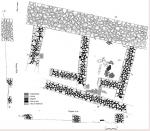Summary (English)
CASTRA RUBRA (Boris Borisov – bdborisov@abv.bg, Gergana Sheyleva) The layer with traces of the fire of AD 600 – 625 was reached in Sector I. House No. 4 and Room No. 1 were explored in Sector II situated from the inner side of the northern fortification wall. The house adjoined the inner side of the fortification wall and measured 3.65 m by 3.05 m. Its walls were 70 – 85 cm wide and were built of mud bricks over foundations constructed of rubble masonry with a bonding medium of mud. The floor was made of trampled soil and there was a hearth in the center of the house. The house was burned. The finds include dolia, an amphora, a pot, a ceramic vessel with carbonized almonds, an iron plough, a millstone, loom weights and arrowheads. Room No. 1 measured 3.40 m by 3.55 m and its construction was identical to the house. Its floor was made of trampled soil. A pit for placing a dolium, dug into the floor, was discovered. The finds include loom weights, small knives, arrowheads and a fibula. Coins minted by Justin II found in the buildings date their occupation to the second half of the 6th century AD. During the first half of the 9th century AD, a settlement emerged over the ruins of the buildings. Mediaeval sherds of that period were found. Eight Christian graves were explored in the necropoleis and thus, their total number reached 20. Three burials (two adults and one child or teenager) were Late Antique. The graves were pits covered with tegulae. The grave goods include a terracotta lamp, a ceramic vessel, hobnails and a coin. The burials date until the initial period of the Gothic War in AD 376 – 378 when Castra Rubra was destroyed. Five graves (three adults and two children) were mediaeval. During the excavations coins of Justin II and Sophia, Maurice and Constantine V were found. After the destruction of the fortress in AD 600 – 625, it was reconstructed as part of the Byzantine fortification system that protected Via Diagonalis.
- Boris Borisov - Department of Archaeology, Veliko Tarnovo University St. Cyril and St. Methodius
- Gergana Sheyleva - Department of Archaeology, Veliko Tarnovo University St. Cyril and St. Methodius
Director
Team
Research Body
- Veliko Tarnovo University St. Cyril and St. Methodius






![Download [PDF]](/excavation/skins/fasti/images/results/download_sml.png)